I know these next few weeks are going to fly by with a busy schedule of working, traveling to the east coast and getting my gear ready for the upcoming trip to Antarctica and Aconcagua. It’s a little tough to pack for this trip, because really, one almost wants two completely different setups to deal with the wet, coastal climate of Antarctica, and the dry, warm and cold climate high on Aconcagua. Add in the trekking, camping and skiing gear, and a gear geek could loose their mind trying to get their kit dialed. Here are a few of the things I know I’m bringing so far.
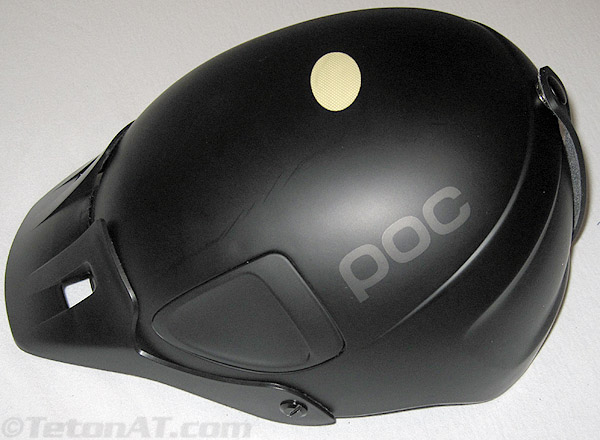
The POC Synapsis is light and certified strong, check it out…here.
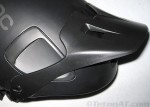 I most likely won’t need a helmet for Aconcagua, and I’m opting to bring a ski helmet to Antarctica in place of a climbing helmet since they tend to merge with goggles better. And at only 375 grams, lighter when you take out all the ear-flaps and insulation, the POC Synapsis doesn’t really
I most likely won’t need a helmet for Aconcagua, and I’m opting to bring a ski helmet to Antarctica in place of a climbing helmet since they tend to merge with goggles better. And at only 375 grams, lighter when you take out all the ear-flaps and insulation, the POC Synapsis doesn’t really 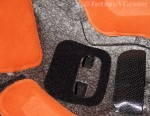 penalize you for wanting some extra features either.
penalize you for wanting some extra features either.
The Synapsis was my first choice of the POC helmet line, because a visor is really nice on a helmet, especially when it’s snowing and blowing out…never mind sunny. The POC’s however, also flips up (it’s 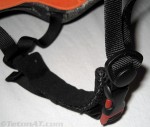 held down with Velcro) so if you want to pop your goggles on your head real quick…it’s not a problem. Add in two forward facing vents that you can block with pieces of fabric on the inside, and you can modify the airflow depending on conditions. I’m sure mine will be set in the open position…forever. POC nails the chin strap as well, which adjusts to anyone’s jaw-shape with ease, and is very comfortable with it’s soft fleecy padding.
held down with Velcro) so if you want to pop your goggles on your head real quick…it’s not a problem. Add in two forward facing vents that you can block with pieces of fabric on the inside, and you can modify the airflow depending on conditions. I’m sure mine will be set in the open position…forever. POC nails the chin strap as well, which adjusts to anyone’s jaw-shape with ease, and is very comfortable with it’s soft fleecy padding.
A headlamp is really only for safety in Antarctica, because of the long days, but will be but more of a necessity for Aconcagua. I’m bringing two, a Black Diamond Spot and Icon. The Spot has to be one of the best batteries in front headlamps out there. Its’ combo of proximity and distance lighting are great and in a relatively light package, and will be good for around camp.
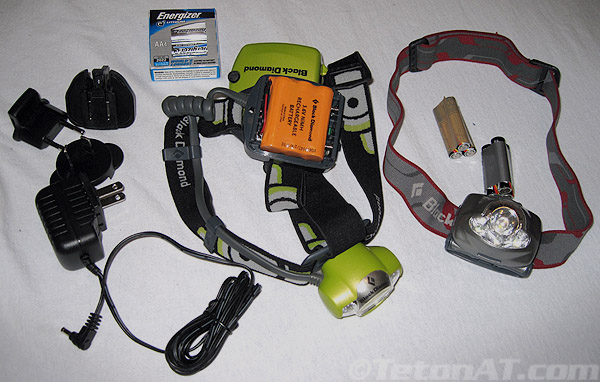
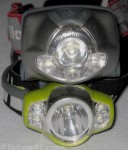 The Icon is more of a workhorse/powerhouse headlamp and since it’s batteries are located in the back, they will stay warm under a hood during the cold morning hours at over 6000m. Add in the NRG kit, a battery recharger, and you’re always rocking full-power when you need it. The NRG also comes with global wall outlet adapters, so you should be able to juice it up wherever. I’ll probably just recharge it here in the states, and bring back up batteries when on Aconcagua.
The Icon is more of a workhorse/powerhouse headlamp and since it’s batteries are located in the back, they will stay warm under a hood during the cold morning hours at over 6000m. Add in the NRG kit, a battery recharger, and you’re always rocking full-power when you need it. The NRG also comes with global wall outlet adapters, so you should be able to juice it up wherever. I’ll probably just recharge it here in the states, and bring back up batteries when on Aconcagua.
Glovewise, I will pretty much need at least four pairs of gloves for Antarctica. Two pairs of approach gloves and two pairs descent gloves. This way, since it is so wet out, I can swap them out each day and let the other pairs dry while we’re out skiing. And depending on just how wet it really is…maybe even have them for backup on each tour. Black Diamond has no less than 53 options for gloves and mittens, so it’s pretty easy to find a model that you like.
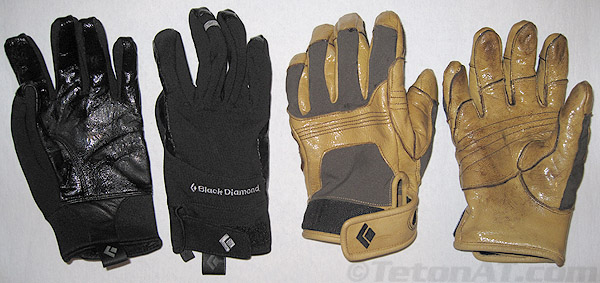
Light is right when it comes to approach gloves and this
ultra-waterproof, Seam-Grip method is bomber.
I don’t know about you, but my hands stay pretty warm when skinning. For this reason (as well as the fact that you’ve always got warmer gloves to put on if your hands get cold), I like very light weight approach gloves. Made with a thin stretch woven material, the Black Diamond Pilot glove is stretchy and breathable, and a neoprene cuff fits snug and comfortably around your wrist. I also like the Transition glove from BD. Its goat leather, is soft and the stretchy section on the back of the hand allow for good mobility and fit. Both of these gloves have spots for clipping on to you pack waist belt or harness, which is nice when you want to snap a picture of your ski partner getting mauled by some killer emperor penguins.
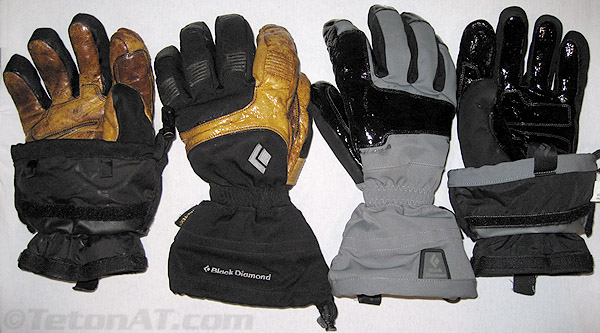
Removable liners, for drying, are key in warmer/heavyweight gloves.
With heavier gloves, I often don’t like the warmest options, because they tend to be too big and bulky for my size medium hands. I’ve been using a pair of BD Prodigy gloves for the past three or four years now and they are still going strong. A Gore-Tex insert in the removable lining, assures dry hands and a combination of Primaloft and fleece add warmth and comfort. Add in a reinforced palm and trigger finger and thumb and the Prodigy is durable and offers good dexterity. The Tour glove is not quite as warm as the Prodigy, and since it uses BDry, it’s less expense than gloves that use GORE products, but still waterproof. Both of these gloves have removable inserts, which is imperative in a warm glove when you are skiing everyday.
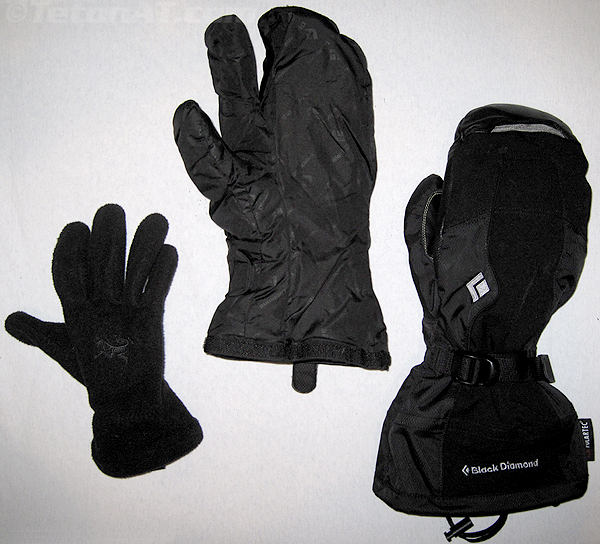
Go ahead hands…just try to get cold…come on!
For Aconcagua I will probably bring only one approach and one descent glove with me when into basecamp, most likely the Pilot and Prodigy. But I will also have an ultra-warm mitten set up, in case things really get cold near the top. The Mercury Mitts from BD are warm and affordable. They are sized large so you can fit a thin liner glove underneath and still have room for a chemical heat pack. The trigger finger on the insert is nice for futzing around camp or putting on crampons and the wrist strap keeps them front moving up and down your hands. Add in some wrist leashes and you won’t loose them when you take them off to wipe snot off your nose or adjust your sunglasses.
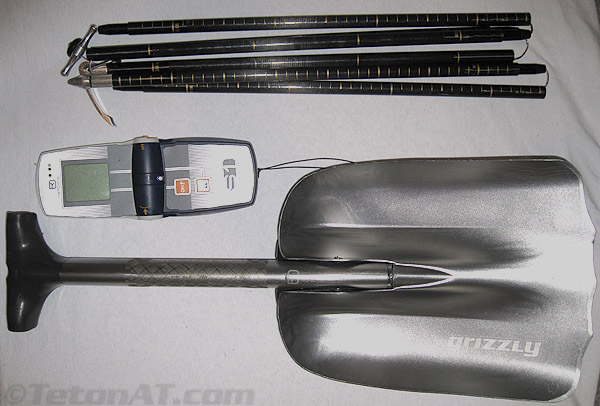
Light, easy to use and effective avalanche tools from Ortovox.
For both Antarctica and Aconcagua I will most likely be skiing with 3-4 other skiers, so I’m opting for lighter weight avalanche gear. I like my Ortovox Grizzly 1 because its handle is quick and easily to deploy since it folds down instead of being removable. It’s also light since it is aluminum and its handle can be locked 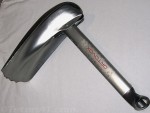 at a 90 degree angle to rack snow away from a victim. I usually poo-poo carbon probes due to their strength limits, but the Ortovox Carbon Pro is one of the few that I feel confident in using for self rescue. Its’ 13mm diameter is stronger than most other carbon probes which tend to be skinnier. It should be no surprise that the S1 is my avalanche transceiver of choice. Skiing with a larger group, it is important to be able to search for multiple victims with ease, which with Ortovox’s signal differentiation and flagging technology…makes very simple and logical. The one caveat is that since the S1 uses information it gets from it’s integrated compass (as well as other information) to determine the direction to a buried transceiver, I have to remember to recalibrate it when I get to the southern hemisphere. Sure hope I remember!
at a 90 degree angle to rack snow away from a victim. I usually poo-poo carbon probes due to their strength limits, but the Ortovox Carbon Pro is one of the few that I feel confident in using for self rescue. Its’ 13mm diameter is stronger than most other carbon probes which tend to be skinnier. It should be no surprise that the S1 is my avalanche transceiver of choice. Skiing with a larger group, it is important to be able to search for multiple victims with ease, which with Ortovox’s signal differentiation and flagging technology…makes very simple and logical. The one caveat is that since the S1 uses information it gets from it’s integrated compass (as well as other information) to determine the direction to a buried transceiver, I have to remember to recalibrate it when I get to the southern hemisphere. Sure hope I remember!

I have used an Icon on a year long mountain climbing trip around the world, and it is great. I use rechargable Li-Ion batteries, light weight and really good in cold temos, better imo than the BD rechargeable.
You really need to try out the Mammut headlamps, way brighter than anything BD made when I was shopping last spring.
rod, how did you recharge your Li-Ion batteries while travelling?
Steve – what kind of light you do feel that the Spot puts out versus say the Petzel Tikka. I have a Tikka and I love its weight, but I have noticed that it really doesn’t put out that good of light on the brightest setting. I am all in favor of brighter if it isn’t adding bulk or weight.
Chris – which Mammut headlamps do you recommend? Does brighter = heavier?
In Mammut headlamps, I like the TX Lite and TX1…in those cases, Bright does not equal heavier.
TX Lite weighs 72G with batteries 80-130h of light, 3 modes and a strobe setting max range of usable light is 41m
TX 1 weighs 150g with batteries 100-400h of light 4 modes with a rear red LED for vis. Max range of usable light is 105m
It seems like Mammut takes the light and focuses it better and gives you a better/brighter beam. What they call “Total Reflex Optics”.
Rod…thanks for the tip. I guess the downside is that those batteries aren’t rechargeable with the NRG kit…so one would need another recharging unit. The cool thing with the Ion and the battery pack (I think) is that a small solar charger could recharge the batteries during the day when you aren’t using it. Still, it seems prudent to carry spare batteries just the same.
Chris…I an familiar with the Mammut headlamps as we sell a couple models at the shop. I like the idea of the NRG with the Icon though…since I rarely use a big bright light…and it’s nice to be able to just plug it in and have full power. I also like the battery power indicators…so you know how much juice is left. Add in the proximity lighting to save power when you don’t need it…and a over the top of the head strap…and your good to go.
Nick…I think the Spot is a better choice than the Tikka (at least the older, proximity lighting only models) since it gives you the added benefit of the spot beam for seeing things at a distance. Most people I know who used to have Tikkas…now own Spots and have been happy with them.
I guess the down side of more power in a headlamp though is less burn time for the batteries…so it’s a trade off as to what’s more important.
I have a Spot and like it, although the dimmer hasn’t worked on mine since soon after I got it (approx. four years ago). I also think the body of the Tikka is more durable. I had a 1st gen. Tikka and hammered on it, and it held up better than the more “flexible-bodied” Spot.
The new Tikka2 and Tikka XP2 (which Steve sort of alluded to above) are much more competitive with the Spot than the old versions. They’ve been in stores for a few weeks now.
I’m probably going to pick up an Icon at some point. The Mammuts look sweet, but in reading up on them, many reviewers remarked that the distance setting is like looking through a tunnel.
Dear POC,
Please send Steve more money. He is such a good salesman that I’ve gone out and purchase 26 new POC helmets.
Your move into the AT crowd has already been a huge success!
Now if only I could jib in the park like the rest of the BRO’s wearing POC lids. Can you sell that?
Money well spent Bruce! I was really surprised at how light the Synapsis was when I took it out of the box. It weighs about the same as many climbing helmets. I will most likely use it without all the earflaps most of the time, since it’s often more about keeping cool when backcountry skiing/ski mountaineering and I can always flip up my hood it the wind picks up.
And POC doesn’t give me any money. 🙂
I’m on the market for a skiing helmet.
On the short list so far i had Giro g10mx ( http://www.giro.com/en-eu/products/snow-helmets/g10mx/ ) for the visor and Giro Omen ( http://www.giro.com/en-eu/products/snow-helmets/omen/ ) for it’s said to be venting well. Giro Fuse looks nice too, might be predecessor model of the Omen even?
The POC looks nice, lightweight and visor is great, but does it vent well?
Can’t really comment too much yet on how well the POC Synapsis vents, but I would say that some of the other models they make, like the Receptor, probably vent better. And if it doesn’t…I’m sure it’s nothing a drill couldn’t fix. 🙂
http://www.pocsports.com/products/products.asp?id=10-Ski
For the record, this is the one I finally got:
http://www.bernunlimited.com/2008/g.html
looks nice.